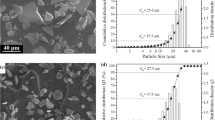Abstract
This research examined the influence of processing parameters on the structure of a Ni-50Cr coating applied by high-velocity oxy-fuel spraying onto stainless steel specimens. This type of coating is normally used as protection against heat and corrosion encountered in power plant and marine boilers, and oil refinery heaters. A statistical design of experiments identified fuel and oxygen flow rates and spraying distance as the most influential parameters controlling the in-flight characteristics of the powder particles prior to impact. The effects of these parameters on the porosity level, oxide content, and microhardness of the coatings were then investigated in more detail. These results indicated that the oxide content and hardness of the coatings were dependent on the gas combustion ratio but not on spraying distance. The porosity level and amount of unmelted particles were reduced at the longest spraying distance.









Similar content being viewed by others
References
D.A. Shifler and L.K. Kohler, Hot Corrosion Resistance and Thermal Stability of High Chromium-Nickel Alloys, Presented at and Published in Proceedings of the NACE International Annual Conference CORROSION/2000, Paper no. 242, NACE, Houston, Texas, 2000
“Standard Specification for Casting, Chromium-Nickel Alloys, A560,” Annual Book of ASTM Standards, ASTM, 2000
J.R. Davis, Ed., Heat-Resistant Materials: ASM Specialty Handbook, ASM, Materials Park, OH, 1997, p 383-384
H.L. Holland, Practical Experience with Countering Metal Dusting in a Methane Reforming Unit, Presented at and Published in Proceedings of the NACE International Annual Conference CORROSION/2001, Paper No. 1385, NACE, Houston, TX, 2001
T. Sundararajan, S. Kuroda, and F. Abe, Effect of Thermal Spray on the Microstructure and Adhesive Strength of High-Velocity Oxy-Fuel-Sprayed Ni-Cr Coatings on 9Cr-1Mo Steel, Metall. Mater. Trans. A, 2004, 35(10), p 3187-3199
T.S. Sidhu, S. Prakash, and R.D. Agrawal, Studies on the Properties of High-Velocity Oxy-Fuel Thermal Spray Coatings for Higher Temperature Applications, Mater. Sci., 2005, 41(6), p 805-823
E. Turunen, “Diagnostic Tools for HVOF Process Optimization,” Ph.D. Thesis, Helsinki University of Technology, 2005
D. Cheng, Q. Xu, E.J. Lavernia, and G. Trapaga, The Effect of Particle Size and Morphology on the In-Flight Behavior of Particles During High-Velocity Oxy-Fuel Thermal Spraying, Metall. Mater. Trans., 2001, B32(3), p 525-535
M.A. Uusitalo, P.M.J. Vuoristo, and T.A. Mäntylä, High Temperature Corrosion of Coatings and Boiler Steels in Reducing Chlorine-Containing Atmosphere, Surf. Coat. Technol., 2002, 161(2-3), p 275-285
T. Keller, W. Wagner, J. Ilavsky, J. Pisacka, G. Barbezat, and P. Fiala, Microstructure-Property Relationships and Cross-Property-Correlations of Thermal Sprayed Ni-Alloy Coatings, Thermal Spray 2001: New Surfaces for a New Millennium, C.C. Berndt, K.A. Khor, and E.F. Lugscheider, Ed., May 28-30, 2001 (Singapore), ASM International, 2001, p 643-652
J.R. Davis, Ed., Handbook of Thermal Spray Technology, Thermal Spray Society, ASM International, OH, 2004, p 338
F. Azarmi, T.W. Coyle, and J. Mostaghimi, Optimization of Atmospheric Plasma Spray Process Parameters using a Design of Experiment for Alloy 625 coatings, J. Therm. Spray Tech., 2008, 17(1), p 144-155
P. Fauchais, A. Vardelle, and B. Dussoubs, Quo Vadis Thermal Spraying?, J. Therm. Spray Tech., 2001, 10(1), p 44-66
H. Zhang, X.Y. Wang, L.L. Zheng, and X.Y. Jiang, Studies of Splat Morphology and Rapid Solidification During Thermal Spraying, Int. J. Heat Mass Trans., 2001, 44(24), p 4579-4592
J. Saaedi, T.W. Coyle, S. Mirdamadi, H. Arabi, and J. Mostaghimi, Phase Formation in a Ni-50Cr HVOF Coating, Surf. Coat. Technol., 2008, 202(24), p 5804-5811
R.K. Roy, Chapter 6, A Primer on the Taguchi Method, Society of Manufacturing Engineers (Dearborn, MI), 1990, p 100-125
V. Higuera, F.J. Belzunce, A. Carriles, and S. Poveda, Influence of the Thermal-Spray Procedure on the Properties of a Nickel-Chromium Coating, J. Mater. Sci., 2002, 37(3), p 649-654
E. Lugscheider, C. Herbst, and L. Zhao, Parameter studies on high-velocity oxy-fuel spraying of MCrAlY coatings, Surf. Coat. Technol., 1998, 108-109(1-3), p 16-23
A.D. Hewitt, Technology of Oxy-Fuel Gas Processes; Part 2: Comparative Combustion Properties of Fuel Gases, Weld. Met. Fab., 1972, 40, p 382-390
H.H. Tawfik and F. Zimmerman, Mathematical Modeling of the Gas and Powder Flow in HVOF Systems, J. Therm. Spray Technol., 1997, 6(3), p 345-352
M. Li and P.D. Christofides, Multi-Scale Modeling and Analysis of an Industrial HVOF Thermal Spray Process, Chem. Eng. Sci., 2005, 60, p 3649-3669
C.M. Hackett and G.S. Settles, Turbulent Mixing of the HVOF Thermal Spray and Coating Oxidation, Thermal Spray Industrial Applications, C.C. Bernt and S. Sampath, Ed., ASM Intentional, Boston, OH, USA, 1994, p 307-312
R.A. Neiser, M.F. Smith, and R.C. Dykhuizen, Oxidation in Wire HVOF-Sprayed Steel, J. Therm. Spray Technol., 1998, 7(4), p 537-545
K. Dobler, H. Kreye, and R. Schwetzke, Oxidation of Stainless Steel in the High Velocity Oxy-Fuel Process, J. Therm. Spray Technol., 2000, 9(3), p 407-413
K. Korpiola, “High Temperature Oxidation of Metal, Alloy and Cermet Powders in HVOF Spraying Process,” Ph.D. Thesis, Helsinki University of Technology, 2004, p 81
J. He, M. Ice, and E. Lavernia, Particle Melting Behavior During High-Velocity Oxygen Fuel Thermal Spraying, J. Therm. Spray Technol., 2001, 10(1), p 83-93
J.F. Li, H.L. Liao, C.X. Ding, and C. Coddet, Optimizing the Plasma Spray Process Parameters of Yttria Stabilized Zirconia Coatings Using a Uniform Design of Experiments, J. Mater. Process. Technol., 2005, 160(1), p 34-42
Acknowledgments
Thanks are expressed to Dr. Larry Pershin and Tiegang Li for help with deposition of the coatings. Partial support for J. Saaedi during the course of this work was provided by the Centre for Advanced Coating Technologies (Prof. Javad Mostaghimi, Director).
Author information
Authors and Affiliations
Corresponding author
Rights and permissions
About this article
Cite this article
Saaedi, J., Coyle, T.W., Arabi, H. et al. Effects of HVOF Process Parameters on the Properties of Ni-Cr Coatings. J Therm Spray Tech 19, 521–530 (2010). https://doi.org/10.1007/s11666-009-9464-5
Received:
Revised:
Published:
Issue Date:
DOI: https://doi.org/10.1007/s11666-009-9464-5




